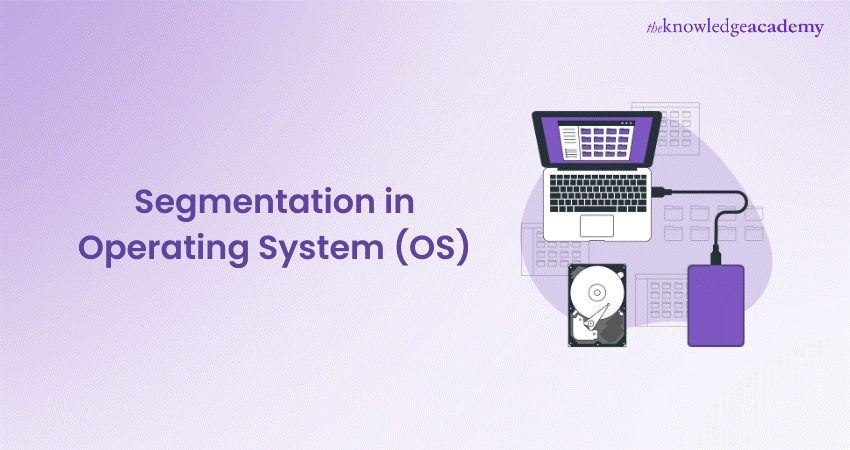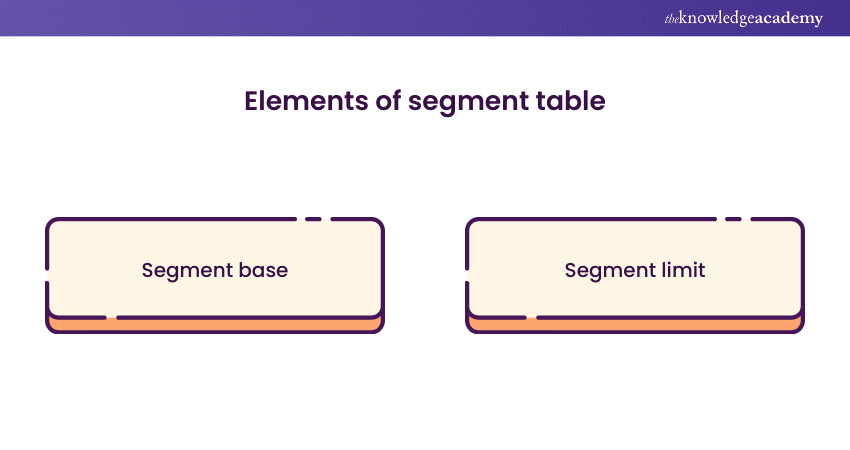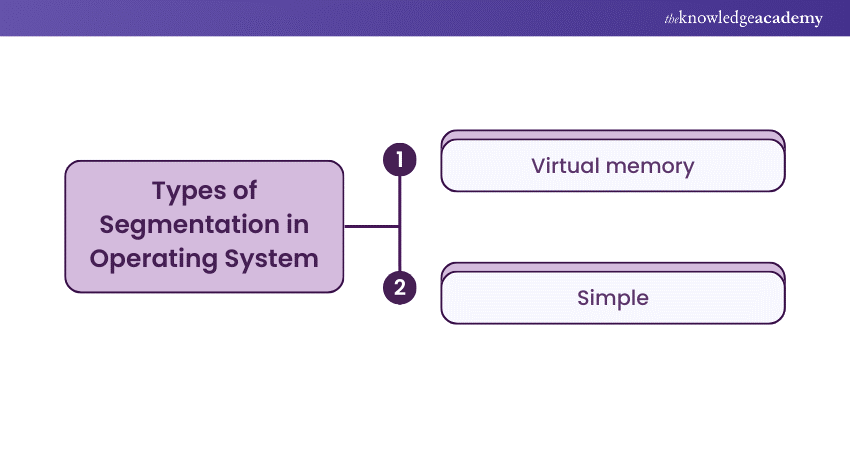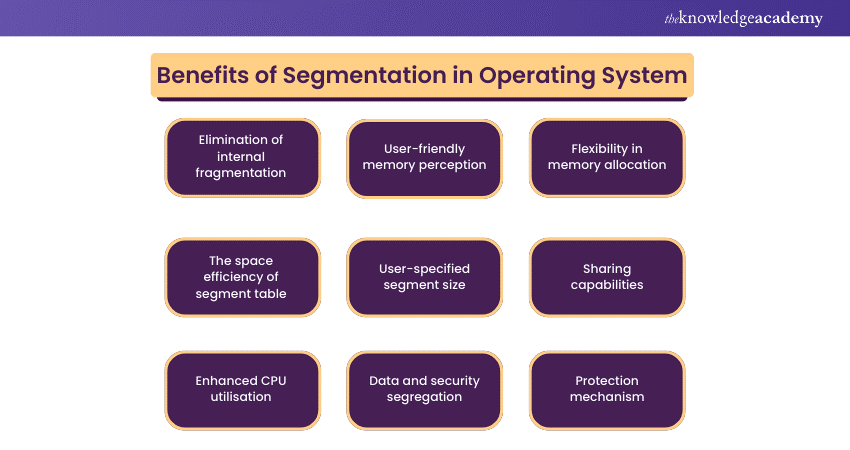We may not have the course you’re looking for. If you enquire or give us a call on +43 720 115337 and speak to our training experts, we may still be able to help with your training requirements.
Training Outcomes Within Your Budget!
We ensure quality, budget-alignment, and timely delivery by our expert instructors.

Segmentation is a memory management technique employed by Operating Systems (OS) to organise and allocate memory for processes in a flexible and modular manner. In this approach, a process is divided into smaller, logically related parts known as segments. Unlike contiguous memory allocation, Segmentation allows these segments to be placed in non-contiguous memory locations, offering a more versatile and efficient utilisation of memory resources.
Segmentation in Operating Systems is a memory management technique that divides the computer's memory into segments, each with its specific purpose. Read more to learn about Segmentation in Operating System!
Table of Contents
1) What is Segmentation in Operating System?
2) Why Segmentation is necessary?
3) What is segment table?
4) Elements of segment table
5) Types of Segmentation in OS
6) Benefits of Segmentation in Operating System
7) Drawbacks of Segmentation in Operating System
8) Example of Segmentation in OS
9) Difference between Segmentation and fragmentation
10) Conclusion
What is Segmentation in Operating System?
Operating Systems (OS) employ various memory allocation and management techniques. Segmentation and paging are two non-continuous memory allocation methods. Segmentation in the Operating System (OS) involves dividing the user program and secondary memory into unevenly sized blocks called segments or sections. On the other hand, paging divides memory into fixed-sized blocks, and processes are segmented into more manageable chunks known as modules. Storing the divided segments in contiguous memory is unnecessary, avoiding internal fragmentation.
The duration of a segment in the user program and memory is determined by its purpose. These are the two non-continuous memory allocation techniques available. Segmentation in the Operating System (OS) divides the user program and secondary memory into unevenly sized blocks known as segments or sections, while paging divides memory into fixed-sized blocks.
Processes are segmented into more manageable chunks, known as modules. Storing the divided segments in contiguous memory is not necessary, preventing internal fragmentation. The duration of a segment in the user program and memory is determined by its purpose.
Why Segmentation is necessary?
Segmentation emerged as a response to challenges observed in the paging technique. Paging involves dividing a function or code into pages, often without consideration for the potential division of related code segments. Consequently, when a process is in execution, the CPU must load multiple pages into frames to ensure that the relevant code is available for execution. More pages are loaded into the main memory, making paging less efficient.
In contrast, Segmentation was introduced as a solution. It involves dividing the code into distinct modules, ensuring that related code segments can be grouped within a single block. This modular approach enhances efficiency by allowing the CPU to load only the necessary elements, reducing the number of pages required to load a process into the main memory.
Another significant drawback of various memory management techniques is separating the actual view of physical memory and the user's perception of physical memory. Segmentation addresses this issue by organising the user's program into segments based on specific requirements, providing a more intuitive and tailored approach to memory management.
What is segment table?
A fundamental data structure known as a segment table comes into play to facilitate the efficient tracking and management of various segments in a program. This table is an organisational cornerstone, encapsulating crucial information about each element, including its base address and limit. The segment table, therefore, becomes an indispensable tool for the Operating System (OS), enabling seamless access and management of distinct segments.
Gain an understanding of HTML structure and content with CSS Introduction & Intermediate Course and stay ahead of the learning curve!
Elements of segment table
The following are the elements of segment table:

1) Segment base
This crucial element denotes the starting address of a particular segment in memory. It is a foundational reference point for efficient memory retrieval during program execution.
2) Segment limit
This element delineates the size or limit of the segment, establishing clear boundaries within which the segment operates. It plays a pivotal role in preventing unintended memory overflows.
Types of Segmentation in OS
The following describes the types of Segmentation in Operating System (OS):

1) Virtual memory
This variant of Segmentation leverages virtual memory techniques to manage segments. It introduces an additional abstraction layer in memory organisation, enhancing the system's adaptability to varying demands.
2) Simple
As the name suggests, this represents the fundamental form of Segmentation. This approach divides the program into segments without incorporating intricate memory management techniques, offering a straightforward yet effective memory organisation.
Benefits of Segmentation in Operating System (OS)
The following are the benefits of Segmentation in Operating System (OS):

1) Elimination of internal fragmentation: One notable advantage of Segmentation lies in its ability to eradicate internal fragmentation. By dividing processes into modules of variable sizes, Segmentation ensures that memory is utilised efficiently without wasting space within individual segments.
2) The space efficiency of segment table: Compared to the page table used in paging, the segment table in Segmentation consumes less space. This compact representation contributes to a more efficient utilisation of memory management resources.
3) Enhanced CPU utilisation: Segmentation enhances CPU utilisation by loading complete modules into memory all at once. This approach ensures that the related code segments necessary for execution are readily available, optimising the processing efficiency of the CPU.
4) User-friendly memory perception: Segmentation aligns the user's perception of physical memory closely with the program's organisational structure. Users can conceptually divide their programs into modules through Segmentation, where each module encapsulates the codes of distinct processes.
5) User-specified segment size: In Segmentation, users can specify the size of each segment, providing a customised approach to memory allocation. This stands in contrast to paging, where the hardware dictates the fixed size of pages.
6) Data and security segregation: Segmentation serves as a method to segregate data, contributing to security operations. This capability allows for a structured separation of sensitive data, enhancing the security protocols within the system.
7) Flexibility in memory allocation: Segmentation offers a higher degree of flexibility compared to paging. The variable size of segments and the ability to design processes with multiple components enable a more fine-grained and adaptable approach to memory allocation.
8) Sharing capabilities: Segmentation facilitates the sharing of memory segments between processes. This feature proves valuable for inter-process communication or sharing code libraries, fostering collaboration and resource optimisation.
9) Protection mechanism: Segmentation introduces a protective layer between segments, preventing unauthorised access or modification of one process's memory segment by another. This inherent protection enhances the overall security and stability of the system.
Segmentation addresses issues such as internal fragmentation and provides a user-friendly and flexible memory management approach. Its efficiency in space utilisation, enhanced CPU utilisation, and support for sharing and protection mechanisms make Segmentation a versatile and powerful memory allocation technique.
Understand the different image formats used on the web with Introduction To HTML Course
Drawbacks of Segmentation in Operating System (OS)
Segmentation, while offering certain benefits in memory management, comes with its own set of drawbacks that need careful consideration. Let's delve into these drawbacks and explore their implications:
External fragmentation:
1) Definition: External fragmentation occurs when free memory space becomes divided into small, non-contiguous segments, rendering some portions of memory unusable even if the total free space is sufficient for a process.
2) Implication: This fragmentation leads to inefficient memory use, as available space may be scattered across various segments, making it challenging to allocate contiguous blocks for more extensive processes.
Overhead:
1) Definition: Overhead refers to the additional resources and complexities a particular technique introduces. In Segmentation, maintaining a segment table for each process contributes to overhead.
2) Implication: The segment table, which contains information about the various segments of a process, requires additional memory space. This increased overhead can impact the overall efficiency of memory utilisation.
Access time impact:
1) Definition: Segmentation introduces a dual-access mechanism, necessitating one memory access for the segment table and another for the main memory.
2) Implication: Accessing two different memory locations for a single instruction retrieval can increase access times. This can result in slower execution of processes and a potential decline in overall system performance.
Complexity in implementation and management:
1) Definition: Compared to more straightforward memory management techniques like paging, Segmentation can be more complex to implement and manage.
2) Implication: Managing multiple segments per process introduces intricacies, making implementing and maintaining Segmentation more challenging. This complexity may require additional effort in system design and maintenance.
Potential for Segmentation faults:
1) Definition: Segmentation faults occur when a program attempts to access unauthorised or non-existent memory regions.
2) Implication: The potential for addressing errors increases with the Segmentation of memory into multiple segments for each process. Programmers must carefully manage and track segment boundaries to avoid unintended access violations.
Increased memory requirements:
1) Definition: The Segmentation approach may increase memory requirements for specific processes.
2) Implication: Each segment table entry consumes additional memory, contributing to the overall memory footprint. This can be a concern in systems with limited memory resources.
Difficulty in handling variable-sized segments:
1) Definition: Managing variable-sized segments, a Segmentation feature, can be challenging.
2) Implication: Dealing with segments of varying sizes introduces complexity in memory allocation and deallocation, as well as in maintaining the coherence of the process.
Example of Segmentation in OS
Consider a multitasking Operating System (OS) running on a computer. In this system, various processes with different functionalities are concurrently executed. The Operating System (OS) uses Segmentation as a memory management technique to organise the memory space for these processes.
Steps of Segmentation in action:
1) Process initialisation: The Operating System (OS) loads multiple processes into the main memory, each representing a distinct application or task to be executed.
2) Division into segments: Each process is divided into logical segments based on its functional components. For example, a text editor process may have elements of code, data, and user interface segments. Each element handles a specific aspect of the process's functionality.
3) Segment table creation: The Operating System (OS) creates a segment table for each process. This table contains entries for each segment, including information such as the base address and limit of the segment in the main memory.
4) Memory allocation: As the processes are loaded into the main memory, the segment table helps allocate memory space for each segment. The base address specifies where the segment begins in the main memory, and the limit indicates the size of the segment.
5) Dynamic memory management: During the execution of a process, Segmentation allows for dynamic allocation and deallocation of memory for each segment. For example, if an operation requires additional memory for a specific segment, the Operating System (OS) can adjust the limit in the segment table accordingly.
6) Efficient resource utilisation: Segmentation facilitates the efficient utilisation of memory resources by allowing related process components to be grouped in a segment. This grouping reduces the need for contiguous memory allocation, minimising internal fragmentation.
7) Context switching: When the Operating System (OS) performs a context switch between different processes, the segment table is updated to reflect the memory space allocated for the newly active process. This allows seamless transition and execution of the following process in the queue.
Problem of fragmentation
Segmentation, while offering advantages in memory management, harbours a significant drawback related to the swapping of processes. A notable issue arises during this swapping process, where processes are loaded into and removed from the main memory. Swapping can occasionally fragment the free memory space, breaking it into smaller pieces corresponding to the segments involved. This fragmentation, known as external fragmentation, poses a substantial challenge within the Segmentation technique.
It is crucial to highlight that Segmentation does not suffer from internal fragmentation, providing a noteworthy contrast to other memory allocation methods. In the context of Segmentation, each process undergoes loading by bringing all associated segments into the main memory.
This loading process involves creating partitions of sizes matching each element, ensuring that every component fits precisely into the dynamically generated partitions of the main memory. As a result, Segmentation is inherently free of internal fragmentation, contributing to more efficient memory utilisation.
Difference between Segmentation and fragmentation
Segmentation distinguishes itself from fragmentation by being a deliberate memory management technique to organise and optimise memory usage. In contrast, fragmentation refers to the unintentional inefficiencies or gaps in memory that can arise during the allocation process, potentially impacting overall system efficiency.
Segmentation is a remarkable memory allocation technique, offering a delicate balance of advantages and challenges. A nuanced understanding of its principles and careful consideration of implementation nuances is imperative for Operating System (OS) designers and administrators seeking to orchestrate optimal memory utilisation in their systems.
Understand front-end and back-end development with Web Development Training and get in-depth knowledge about front-end frameworks like Bootstrap and jQuery
Conclusion
While Segmentation offers significant advantages in terms of flexibility and efficient memory organisation, it is not without its challenges. The potential for external fragmentation and the complexity associated with managing multiple segments per process require careful consideration during system design and implementation. We hope you have understood Segmentation in Operating System (OS) through this blog!
Develop your skills in application development with App & Web Development Training and stay ahead of the learning curve!
Frequently Asked Questions

Segmentation is a memory management technique used in operating systems to enhance the efficiency of memory utilisation. In this approach, a program's address space is divided into variable-sized segments, each representing a logical unit of the program, such as code, data, or stack. Unlike the fixed-size partitions used in other memory management techniques like paging, segmentation allows for a more flexible allocation of memory resources based on the specific needs of the program.

In a segmented memory model, each segment has a distinct identifier and length. When a program is loaded into memory, the operating system keeps track of the base address and length of each segment. When the program accesses memory, a two-dimensional address is used, consisting of a segment identifier and an offset within that segment. The operating system translates this logical address into a physical address by adding the base address of the corresponding segment to the offset.

The benefits of segmentation include improved modularity, support for dynamic data structures, and efficient code sharing among multiple processes. However, it introduces challenges like fragmentation, both internal and external. Internal fragmentation occurs when there is unused memory within a segment, while external fragmentation results from unused memory scattered throughout the system. Despite these challenges, segmentation offers advantages such as modular program structures and dynamic data structure support. On the downside, implementing and managing segmentation can be more complex than simpler memory management techniques, and there is an associated overhead due to address translation, impacting system performance to some extent.

The Knowledge Academy takes global learning to new heights, offering over 30,000 online courses across 490+ locations in 220 countries. This expansive reach ensures accessibility and convenience for learners worldwide.
Alongside our diverse Online Course Catalogue, encompassing 17 major categories, we go the extra mile by providing a plethora of free educational Online Resources like News updates, blogs, videos, webinars, and interview questions. Tailoring learning experiences further, professionals can maximise value with customisable Course Bundles of TKA.

The Knowledge Academy offers various App and Development Courses including web development foundation, HTML Courses, and Website Design. These courses cater to different skill levels, providing comprehensive insights into Web Development Training methodologies.
Our Programming and DevOps blogs covers a range of topics related to Web Development, offering valuable resources, best practices, and industry insights. Whether you are a beginner or looking to advance your Project Management skills, The Knowledge Academy's diverse courses and informative blogs have you covered.

The Knowledge Academy’s FlexiPass is a pre-paid training voucher that is built specifically for clients and their dynamic needs. It provides access to a wide range of courses, at a pre-determined price, with robust safety measures. FlexiPass gives clients the added benefit of upskilling on a budget that best fits them.
Upcoming Programming & DevOps Resources Batches & Dates
Date
 Web Development Training
Web Development Training
Fri 14th Feb 2025
Fri 11th Apr 2025
Fri 13th Jun 2025
Fri 15th Aug 2025
Fri 10th Oct 2025
Fri 12th Dec 2025







 Top Rated Course
Top Rated Course



 If you wish to make any changes to your course, please
If you wish to make any changes to your course, please


